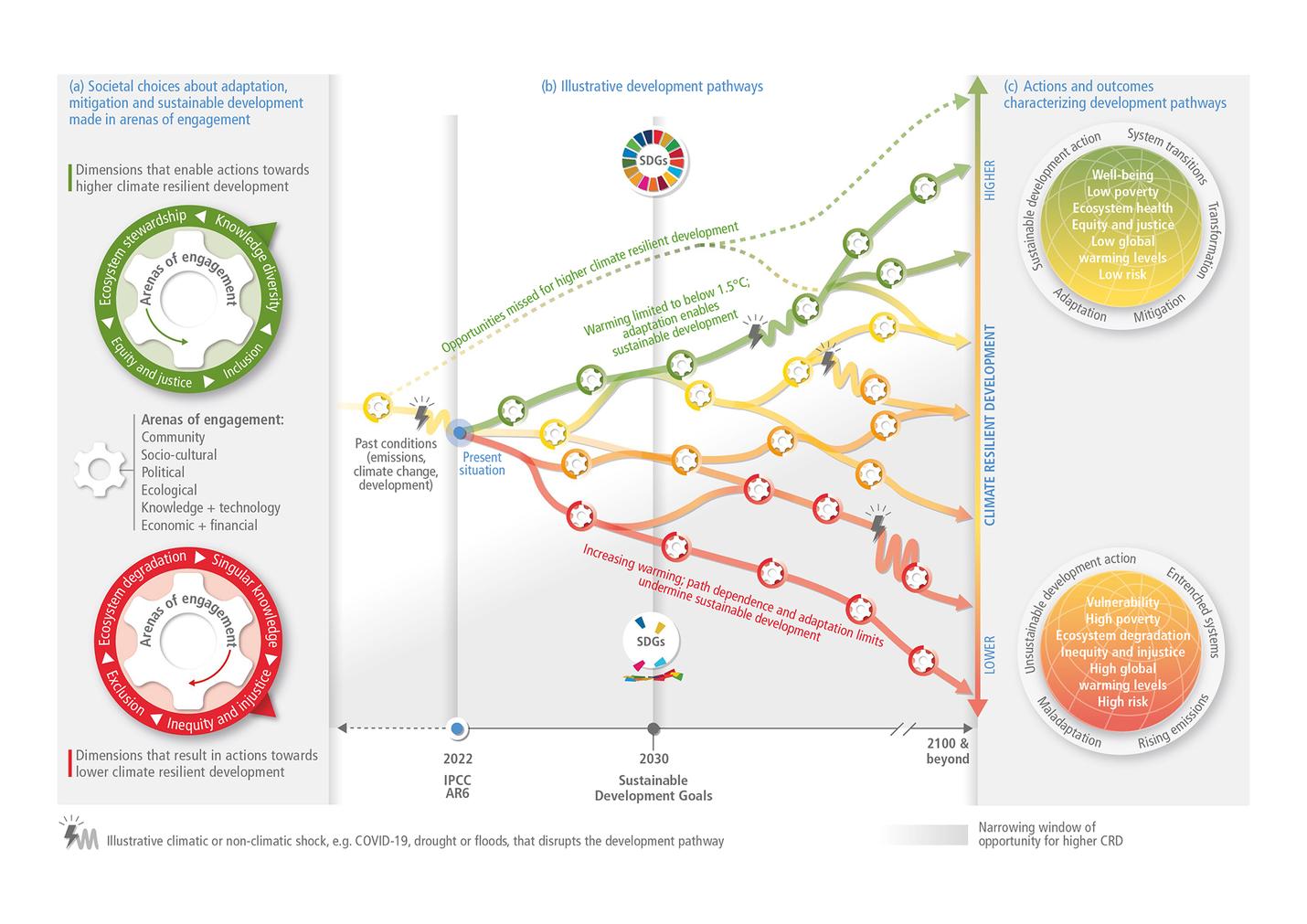Intergovernmental Panel on Climate Change (IPCC)
Climate Change 2022 - Impacts, Adaptations and Vulnerability
Summary for Policymakers
<- Image: Climate Resilient Development Possible Outcomes
A. Introduction
Adaptation plays a key role in reducing exposure and vulnerability to climate change... In human systems, adaptation can be anticipatory or reactive, as well as incremental and/or transformational.
B. Observed and Projected Impacts and Risks
1.6. Non-climatic factors including some patterns of settlement, and siting of infrastructure have contributed to the exposure of more assets to extreme climate hazards increasing the magnitude of the losses (high confidence).
1.7. Climate change is contributing to humanitarian crises where climate hazards interact with high vulnerability (high confidence).
3.1. If trends in urbanisation in exposed areas continue, this will exacerbate the impacts, with more challenges where energy, water and other services are constrained (medium confidence).
4.5. Costs for maintenance and reconstruction of urban infrastructure, including building, transportation, and energy will increase with global warming level (medium confidence), the associated functional disruptions are projected to be substantial particularly for cities, settlements and infrastructure located on permafrost in cold regions and on coasts (high confidence).
5.2. Adverse impacts from climate hazards and resulting risks are cascading across sectors and regions (high confidence), propagating impacts along coasts and urban centres (medium confidence) and in mountain regions (high confidence).
C. Adaptation Measures and Enabling Conditions
1.0. Progress in adaptation planning and implementation has been observed across all sectors and regions, generating multiple benefits (very high confidence).
1.2. Most observed adaptation is fragmented, small in scale, incremental, sector-specific, designed to
respond to current impacts or near-term risks, and focused more on planning rather than implementation (high confidence).
[G]aps are partially driven by widening disparities between the estimated costs of adaptation and documented finance allocated to adaptation (high confidence).
2.6. Considering climate change impacts and risks in the design and planning of urban and rural settlements and infrastructure is critical for resilience and enhancing human well-being (high confidence).
2.7. An increasing number of adaptation responses exist for urban systems, but their feasibility and effectiveness is constrained by institutional, financial, and technological access and capacity, and depends on coordinated and contextually appropriate responses across physical, natural and social infrastructure (high confidence).
2.9. Social safety nets that support climate change adaptation have strong co-benefits with development goals such as education, poverty alleviation, gender inclusion and food security. (high confidence).
3.0. Soft limits to some human adaptation have been reached, but can be overcome by addressing a range of constraints, primarily financial, governance, institutional and policy constraints (high confidence).
4.0. There is increased evidence of maladaptation across many sectors and regions since the AR5.
4.4. To minimize maladaptation, multi-sectoral, multi-actor and inclusive planning with flexible pathways encourages low-regret and timely actions that keep options open, ensure benefits in multiple sectors and systems and indicate the available solution space for adapting to long-term climate change (very high confidence).
5.5. Monitoring and evaluation (M&E) of adaptation are critical for tracking progress and enabling effective adaptation (high confidence).
Although most of the monitoring of adaptation is focused towards planning and implementation, the monitoring of outcomes is critical for tracking the effectiveness and progress of adaptation (high confidence).
D. Climate Resilient Development
1.1. There is a rapidly narrowing window of opportunity to enable climate resilient development.
1.3. Dynamic trade-offs and competing priorities exist between mitigation, adaptation, and development. Integrated and inclusive system-oriented solutions based on equity and social and climate justice reduce risks and enable climate resilient development (high confidence).
2.1. Climate resilient development is advanced when actors work in equitable, just and enabling ways to reconcile divergent interests, values and worldviews, toward equitable and just outcomes (high confidence).
Evidence shows that climate resilient development processes link scientific, Indigenous, local, practitioner and other forms of knowledge, and are more effective and sustainable because they are locally appropriate and lead to more legitimate, relevant and effective actions (high confidence).
3.0. Interactions between changing urban form, exposure and vulnerability can create climate change-induced risks and losses for cities and settlements. However, the global trend of urbanisation also offers a critical opportunity in the near-term, to advance climate resilient development (high confidence).
Climate resilient development in urban areas also supports adaptive capacity in more rural places through maintaining peri-urban supply chains of goods and services and financial flows (medium confidence).
March 2022
Read more here: https://www.ipcc.ch/report/ar6/wg2/
